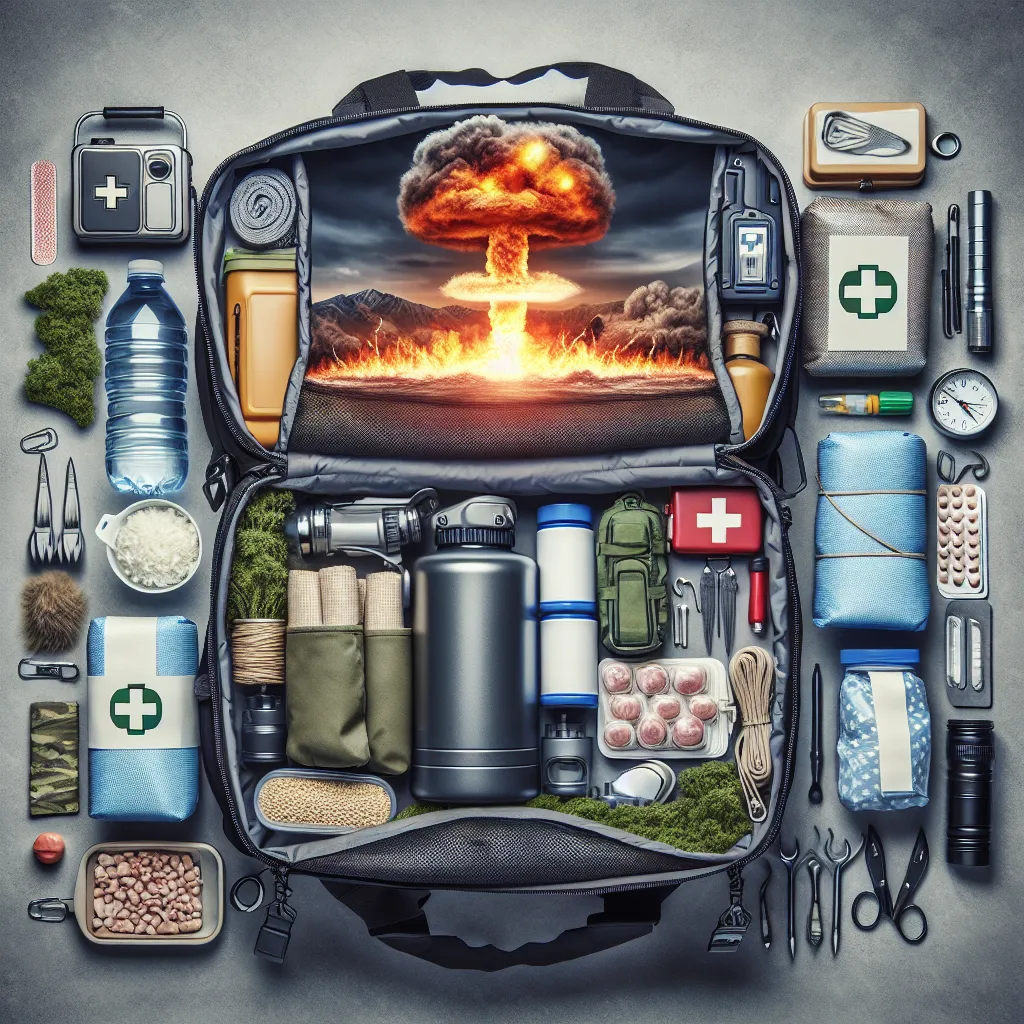The article thoroughly delves into the critical role of rations in survival scenarios, emphasizing their significance in providing sustenance, stability, and effective resource management. It highlights how properly allocated rations contribute to both physical and mental well-being, underscoring their crucial role in maintaining strength and resilience in challenging environments. Furthermore, the piece underscores the importance of understanding essential nutrients for sustained survival and offers practical advice on prioritizing foods rich in proteins, carbohydrates, fats, and other vital elements. Additionally, it stresses the essentiality of ration planning for long-term survival, emphasizing the need for informed decisions about ration allocation and storage to optimize available resources. Overall, the article provides compelling insights and practical guidance, making it a must-read for anyone seeking to enhance their preparedness and survival skills in adverse situations.
10 Essential Items for Your Disaster Preparedness Kit
In the article “Water and Water Purification,” the importance of preparing for a disaster by including water and water purification supplies in an emergency kit is emphasized. Clean drinking water and safe water access are vital for survival, with suggestions for including several gallons of water per person, purification tablets or drops, portable water filters, and clean water storage containers. The section on “Non-Perishable Food Supplies” underscores the significance of including long-lasting food items such as canned goods, dried foods, and a manual can opener in a disaster preparedness kit, highlighting the essential nutrients and sustenance they provide when fresh food is unavailable. Lastly, in “Emergency Shelter and Warmth,” the article stresses the necessity of including items like a tent, thermal emergency blanket, and portable heat source, all crucial for providing emergency shelter and warmth during various emergency situations. The detailed and practical advice provided in the article encourages readers to thoroughly prepare for unforeseen emergencies by including these essential items in their disaster preparedness kits.
Key Steps to Creating an Effective Disaster Preparedness Plan
The article discusses the importance of understanding potential disasters and the essential components of a disaster preparedness plan. It emphasizes the significance of conducting a comprehensive risk assessment to identify natural and man-made threats and collaborating with local authorities and stakeholders. The article also highlights the key components of a successful disaster preparedness plan, including risk assessment, communication protocols, response procedures, business continuity planning, and regular training. Furthermore, it emphasizes the crucial steps of implementing and testing the plan to ensure its effectiveness during a crisis. Overall, the article provides valuable insights into creating a robust disaster preparedness plan, making it a must-read for organizations and communities looking to enhance their readiness and resilience.
Challenges and Opportunities in Delivering Effective Aid
The article “The Impact of Political Instability on Aid Effectiveness” delves into the challenges and far-reaching impacts of political instability on aid distribution. It highlights how instability hinders aid delivery, leads to corruption, and politicizes aid efforts, ultimately affecting the most vulnerable populations. Despite these challenges, the article outlines opportunities to improve aid effectiveness by addressing root causes of instability and adopting context-specific strategies. In conclusion, it emphasizes the profound impact of political instability on aid effectiveness and the potential for mitigating these challenges. The second article focuses on “Harnessing Technology for Efficient Aid Delivery,” emphasizing the opportunities presented by technology, such as mobile applications, remote sensing, blockchain, and artificial intelligence, in improving aid distribution. The article’s comprehensive approach and emphasis on addressing these pressing issues make it a compelling read for those interested in aid effectiveness and technological advancements in humanitarian efforts.
The Importance of Aid in Developing Countries
The article delves into the crucial role of foreign aid in the economic development of developing nations by providing essential financial resources, promoting economic growth, fostering stability, and addressing structural challenges. It emphasizes the importance of strategic, transparent, and harmonized aid efforts to maximize their positive impact on the economy and society. Furthermore, the article highlights the pivotal role of international aid in improving healthcare and education in developing countries, contributing to the long-term well-being and prosperity of the population. Additionally, it underlines the significance of aid in promoting sustainable development and ending poverty by implementing long-term solutions and addressing root causes. The comprehensive insights presented in the article make it a compelling read for anyone keen on understanding the intricate dynamics of foreign aid and its impact on developing nations.
The Importance of Safety Gear in High-Risk Environments
The importance of safety gear in high-risk industrial environments cannot be overstated. Protective equipment, including helmets, goggles, gloves, and specialized clothing, serves as a vital defense against workplace hazards, ultimately ensuring the well-being of workers. Beyond physical protection, the use of safety gear enhances overall work efficiency by allowing employees to focus on their tasks without constant worry about potential dangers. Moreover, it fosters a culture of responsibility and risk awareness. Employers should prioritize the provision of appropriate safety gear and ensure that employees are trained in its correct usage to create a secure work environment. For a comprehensive understanding of the crucial role of safety gear in industrial work, this article offers valuable insights into its significance and impact, making it a must-read for anyone in high-risk fields.
The Impact of Food Advertising on Childrens Eating Habits
The article explores the significant influence of TV food ads on children’s eating habits and food choices. It highlights how the constant exposure to persuasive commercials promoting unhealthy foods and beverages on television impacts children’s dietary behaviors, leading to cravings and preferences for these products. Moreover, it discusses the potential contribution of food advertising to the development of poor eating habits, weight gain, and the risk of chronic health conditions such as obesity and diabetes in children. The article also emphasizes the growing call for stricter regulations and limitations on the marketing of unhealthy foods to children and suggests promoting nutritious foods and responsible marketing practices to positively impact children’s dietary behaviors and overall health. Additionally, it delves into the relationship between junk food marketing and childhood obesity, highlighting the concerning findings from numerous studies that indicate the vulnerability of children to persuasive food advertising and the association between exposure to junk food marketing and increased consumption of unhealthy products, ultimately contributing to the normalization of unhealthy eating habits. The comprehensive analysis and the call for proactive measures make the article a compelling read for anyone interested in understanding and addressing the impact of TV food ads on children’s food choices.
The Impact of Sustainable Packaging on the Environment
The article delves into the paramount significance of sustainable packaging for environmental conservation. It emphasizes how sustainable packaging minimizes the use of non-renewable resources and reduces waste sent to landfills, consequently conserving natural resources and lowering the carbon footprint. Additionally, it highlights the role of eco-friendly materials in protecting ecosystems and wildlife, promoting responsible consumption and production, and mitigating climate change. The advancement in eco-friendly packaging solutions, such as biodegradable materials and reusable packaging, has significantly reduced the environmental impact of the packaging industry. Moreover, it underscores the crucial role that businesses play in promoting sustainable packaging practices to meet the growing demand for environmentally conscious products. This comprehensive exploration of sustainable packaging’s multifaceted benefits undoubtedly underscores the urgency and relevance of embracing sustainable packaging practices.
Essential Emergency Gear for Every Survival Kit
The article “Top 10 Must-Have Items for Survival Kits” highlights essential gear for emergency preparedness, including a water filtration system, fire starter, emergency shelter, first aid kit, multi-tool, high-calorie food rations, navigation tools, emergency communication devices, protective gear, and an emergency whistle. Each item is described in detail, emphasizing its importance in various emergency scenarios. Additionally, the article emphasizes the significance of building the ultimate emergency gear arsenal, stressing the necessity of a reliable backpack, multitool, shelter, warmth, water filtration, and food access for emergency preparedness. By including these essential items in a survival kit, readers can increase their chances of survival and better handle unexpected emergencies.
Essential Disaster Preparedness Tips for Every Household
In this comprehensive article, the importance of creating an emergency preparedness kit for your home is highlighted, emphasizing the role of a well-stocked kit in ensuring safety and well-being during crises. The article provides a detailed list of essential items to include, such as water, non-perishable food, first aid kit, flashlights, emergency radio, personal hygiene items, important documents, and tools, tailored to cater to specific family needs. It also underlines the significance of regular review and updates to the kit’s contents, emphasizing the proactive steps to safeguard loved ones during unexpected disasters. The accompanying section on establishing a family disaster plan further reinforces the need for thorough preparation and clear communication to ensure safety and well-being. This insightful and practical guide is a must-read for anyone seeking to protect their family in the face of unforeseen emergencies.









